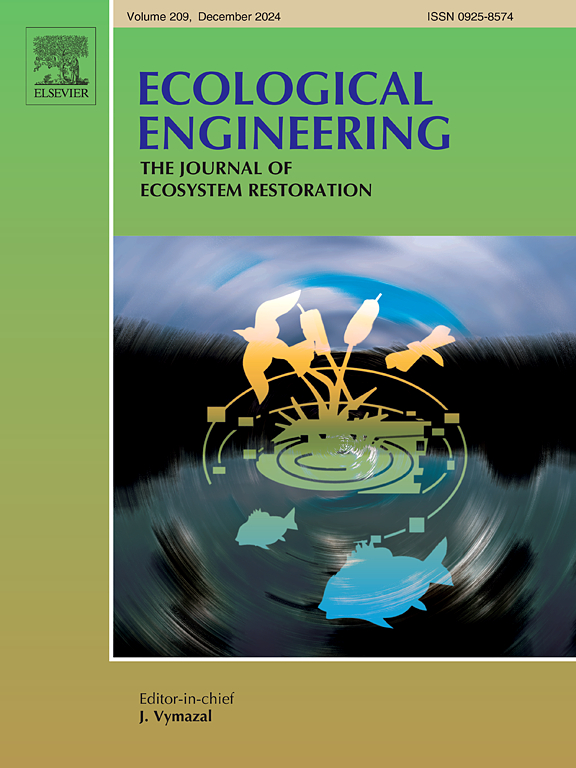不同流域造林模式下38年无灌溉梭梭人工林恢复状况
IF 4.1
2区 环境科学与生态学
Q1 ECOLOGY
引用次数: 0
摘要
在准噶尔盆地南缘沙漠-绿洲过渡带,有限的降水和粘质土壤对灌丛林生态屏障构成了重大挑战。20世纪80年代,为解决土地沙漠化问题,启动了大规模梭梭人工林项目。本研究以莫梭湾垦区依然繁茂的无灌溉梭梭人工林为研究对象,调查分析了不同造林模式下人工林的林分特征和土壤条件,研究了不同造林模式下人工林的恢复情况,确定了干旱区人工林的适宜种植模式。结果表明,种植密度为480 ~ 625株/ha的梭梭人工林在38年无灌溉后形成了稳定的群落。植被盖度保持在9.06% ~ 34.27%之间,土壤湿度保持在5%以上,达到自然群落水平。因此,每公顷480棵树的种植密度,植物间距为6米,行间距为3.5米,最有利于植物的生长和生存,从而创建一个不需要灌溉的可持续人工森林。本研究结果为荒漠-绿洲过渡带生态系统的恢复与维护提供了有价值的见解。本文章由计算机程序翻译,如有差异,请以英文原文为准。
Restoration status of 38-year-old Haloxylon ammodendron plantations without irrigation under different catchment afforestation models
In the desert-oasis transition zone at the southern edge of the Junggar Basin, limited precipitation and clayey soil pose significant challenges for shrub forest ecological barriers. In the 1980s, a large-scale Haloxylon ammodendron plantations project was initiated to address land desertification. This study focused on No-irrigation H. ammodendron plantation forests, still thriving in the Mosuowan reclamation area, forest stand characteristics and soil conditions were surveyed and analysed to study the recovery of artificial forests under different afforestation models and to determine the appropriate planting model for artificial forests in arid areas. The results showed that H. ammodendron plantations with a planting density of 480–625 Plants/ha formed stable communities after 38 years without irrigation. Their retention rate is above 60 %, vegetation coverage remains at 9.06 %–34.27 %, and soil moisture is above 5 %, reaching natural community levels. Therefore, a planting density of 480 trees per hectare, with a spacing of 6 m between plants and 3.5 m between rows, is most conducive to plant growth and survival, enabling the creation of a sustainable artificial forest that does not require irrigation. The findings of this study offer valuable insights for the restoration and maintenance of ecosystems in desert-oasis transition zones.
求助全文
通过发布文献求助,成功后即可免费获取论文全文。
去求助
来源期刊

Ecological Engineering
环境科学-工程:环境
CiteScore
8.00
自引率
5.30%
发文量
293
审稿时长
57 days
期刊介绍:
Ecological engineering has been defined as the design of ecosystems for the mutual benefit of humans and nature. The journal is meant for ecologists who, because of their research interests or occupation, are involved in designing, monitoring, or restoring ecosystems, and can serve as a bridge between ecologists and engineers.
Specific topics covered in the journal include: habitat reconstruction; ecotechnology; synthetic ecology; bioengineering; restoration ecology; ecology conservation; ecosystem rehabilitation; stream and river restoration; reclamation ecology; non-renewable resource conservation. Descriptions of specific applications of ecological engineering are acceptable only when situated within context of adding novelty to current research and emphasizing ecosystem restoration. We do not accept purely descriptive reports on ecosystem structures (such as vegetation surveys), purely physical assessment of materials that can be used for ecological restoration, small-model studies carried out in the laboratory or greenhouse with artificial (waste)water or crop studies, or case studies on conventional wastewater treatment and eutrophication that do not offer an ecosystem restoration approach within the paper.
 求助内容:
求助内容: 应助结果提醒方式:
应助结果提醒方式:


